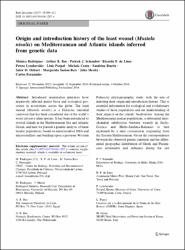Origin and introduction history of the least weasel (Mustela nivalis) on Mediterranean and Atlantic islands inferred from genetic data

View/
Access
info:eu-repo/semantics/closedAccessDate
2017Author
Rodrigues, MonicaBos, Arthur R.
Schembri, Patrick J.
de Lima, Ricardo F.
Lymberakis, Petros
Parpal, Lluis
Cento, Michele
Metadata
Show full item recordAbstract
Introduced mammalian predators have negatively affected native biota and ecological processes in ecosystems across the globe. The least weasel (Mustela nivalis) is a Holarctic mustelid carnivore that has been considered one of the world's worst invasive alien species. It has been introduced to several islands in the Mediterranean Sea and Atlantic Ocean, and here we present a genetic analysis of these insular populations, based on mitochondrial DNA and microsatellites and building upon a previous Western Palearctic phylogeographic study, with the aim of inferring their origin and introduction history. This is essential information for ecological and evolutionary studies of those populations and our understanding of their impacts on the islands' biodiversity. Among the Mediterranean insular populations, a substantial mitochondrial subdivision between weasels in Sicily-Corsica and Malta-Sardinia-Balearics is best explained by a dual colonization originating from the Eastern Mediterranean. Given the correspondence between the observed genetic partition and the differential geographic distribution of Greek and Phoenician settlements and influence during the last millennium BC in those islands, we propose that weasels may have been introduced into the first group of islands by the Greeks and into the second group by the Phoenicians. There is strong support that the commercial and demographic expansions of Phoenicians and Greeks allowed the colonization of the western Mediterranean islands by the house mouse, and texts from Classical Antiquity show evidence that weasels were used for rodent control. Thus, weasels may have been intentionally introduced to the islands, with the aim of controlling commensal rodents. Besides indicating Eastern Mediterranean origins for weasels in Mediterranean islands, the mitochondrial data also revealed an unanticipated close genealogical connection between some of these populations and those from the Azores and So Tom,. The latter island populations showed no affinities with weasels from mainland Portugal, contrary to what might have been expected given that these Atlantic islands were settled by the Portuguese. The microsatellite data also supported the relationship between weasels in Atlantic and in Mediterranean islands. Considering geographic proximity and historical information, the most parsimonious explanation for the origin of the Atlantic weasels appears to be introduction from the Balearic Islands to the Azores and from there to Sao Tome.

















